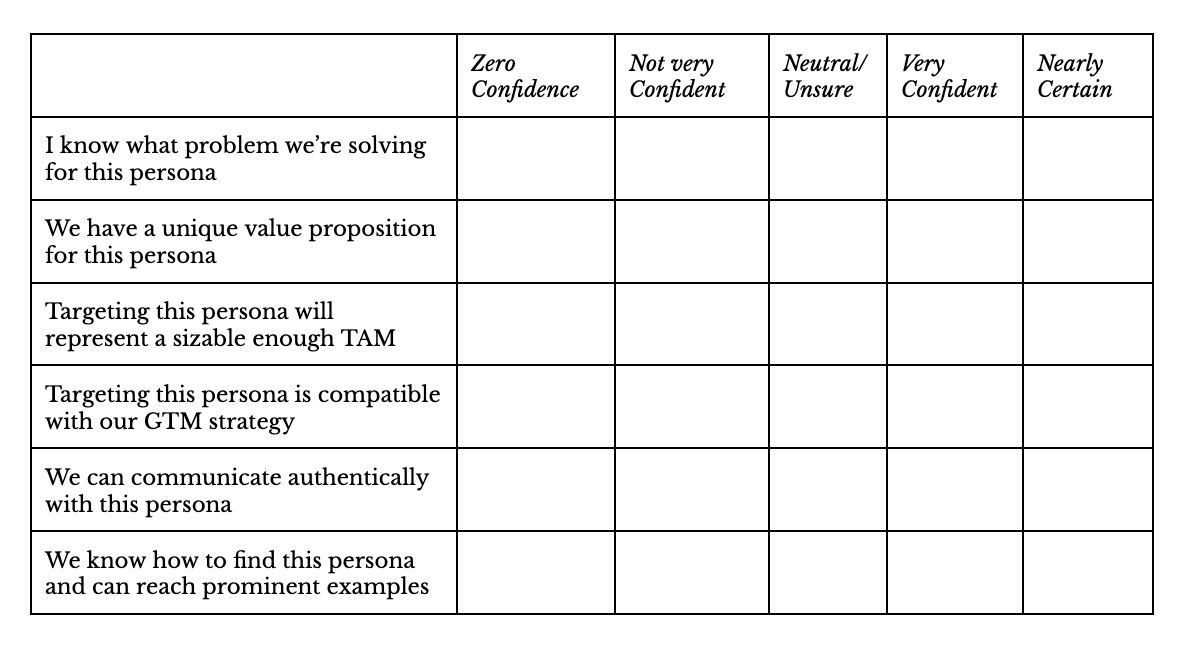When it comes to determining who to market to, we’re big believers in the idea that, to start, you only need one buyer persona. If you’re wondering how we arrived at that conclusion, check out the post from 2018 and then come back here for some good next steps. If you’re convinced that walking before you run is the right way to approach persona-driven marketing, and you’re wondering how to choose which persona to start with, then the rest of this post is for you.
The essential question is – If you only need one buyer persona (for now), how do you choose which one to start with? This worksheet and accompanying documentation is designed to help you decide.
Evaluation criteria
Our evaluation framework is based on these three pillars of persona validation:
- Product Strength - How good is your product in the eyes of this potential audience?
- Market Size - Is this persona’s segment too niche? Or not niche enough?
- Distribution Strategy - Assuming this is the right persona, how are you going to reach them, and can you communicate with them authentically?
First, start out by listing the personas you’re considering marketing to. We recommend limiting this initial list to just three personas – and make sure they’re different enough to warrant the kind of scrutiny we’re about to put them through. If you’re unsure of how to generate this list, this post can help you with that.
The Questionnaire
Next, for each of these personas, fill out the following questionnaire. You can also invite anyone on your team to fill it out. If you’re going to take that approach, we recommend sending out a brief description of each of the personas you’re considering, so that everyone is as calibrated as possible when it comes time to evaluate them.
 We’ve also the form available in Google Doc format here.
We’ve also the form available in Google Doc format here.
A rubric: What to do with the results?
If you want to take a quantitative approach to your decision, or make a data-driven decision, you can score each candidate according to the following point values for each value in the Likert scale style questions:
Zero Confidence: -2
Not very Confident: -1
Neutral/Unsure: 0
Very Confident: 1
Nearly Certain: 2
As a start, you can judge the overall confidence you have in each of your potential candidates. Keep in mind that that assumes that each of the questions and pillars are equally impactful – a question that is open for debate.
When it comes down to it, we essentially recommend that you go with the group you know the best. You’re going to be able to clearly see who you’re able to fill out all of these questions for, and who you aren’t. You may have a gut feeling that chasing after a particularly hot segment right now (“AI Infrastructure Engineers”) might be a good long-term strategy, but it might not be, if you don’t know them well. Going with the group you know the best will give you the best opportunity to effectively measure your messaging and positioning to a well-defined group who you know how to communicate with.
The fact of the matter is, if you attempt to target a market segment that you don’t know how to authentically with, you might have a hard time getting off the ground. Additionally, if it’s not a segment you knwo very well, how sure can you be that you’ve built a product that will uniquely benefit them?
Some more tips on getting the most out of this process:
- Recognize that persona choice and go-to-market motions are inextricably linked. If you don’t want to be involved in a top-down motion involving enterprise sales and a lot of contract negotiation, make sure your persona isn’t “CTO” or “VP of Eng at a $100MM ARR Software Company”
- Be brutally honest with yourself about Question #3 specifically. If you’re confident about #1 and #2, but have no ideas about #3, you might want to reconsider your approach
- Imagine yourself putting together a landing page or marketing site home page directed toward this persona – can you start to visualize the necessary content to entice this individual?
You’ve chosen – now what?
Once you’ve made the decision to start with one of your personas, what should you do next? We recommend thinking more about how you’re going to communicate with them. It’s time to think about the Value Story.
